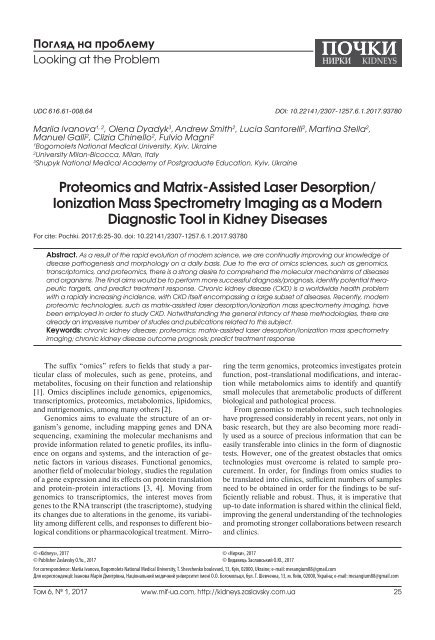Журнал "Почки" №1 (19) 2017
Create successful ePaper yourself
Turn your PDF publications into a flip-book with our unique Google optimized e-Paper software.
Ïîãëÿä íà ïðîáëåìó<br />
Looking at the Problem<br />
UDC 616.61-008.64 DOI: 10.22141/2307-1257.6.1.<strong>2017</strong>.93780<br />
Mariia Ivanova 1, 2 , Olena Dyadyk 3 , Andrew Smith 2 , Lucia Santorelli 2 , Martina Stella 2 ,<br />
Manuel Galli 2 , Clizia Chinello 2 , Fulvio Magni 2<br />
1<br />
Bogomolets National Medical University, Kyiv, Ukraine<br />
2<br />
University Milan-Bicocca, Milan, Italy<br />
3<br />
Shupyk National Medical Academy of Postgraduate Education, Kyiv, Ukraine<br />
Proteomics and Matrix-Assisted Laser Desorption/<br />
Ionization Mass Spectrometry Imaging as a Modern<br />
Diagnostic Tool in Kidney Diseases<br />
For cite: Pochki. <strong>2017</strong>;6:25-30. doi: 10.22141/2307-1257.6.1.<strong>2017</strong>.93780<br />
Abstract. As a result of the rapid evolution of modern science, we are continually improving our knowledge of<br />
disease pathogenesis and morphology on a daily basis. Due to the era of omics sciences, such as genomics,<br />
transcriptomics, and proteomics, there is a strong desire to comprehend the molecular mechanisms of diseases<br />
and organisms. The final aims would be to perform more successful diagnosis/prognosis, identify potential therapeutic<br />
targets, and predict treatment response. Chronic kidney disease (CKD) is a worldwide health problem<br />
with a rapidly increasing incidence, with CKD itself encompassing a large subset of diseases. Recently, modern<br />
proteomic technologies, such as matrix-assisted laser desorption/ionization mass spectrometry imaging, have<br />
been employed in order to study CKD. Notwithstanding the general infancy of these methodologies, there are<br />
already an impressive number of studies and publications related to this subject.<br />
Keywords: сhronic kidney disease; proteomics; matrix-assisted laser desorption/ionization mass spectrometry<br />
imaging; сhronic kidney disease outcome prognosis; predict treatment response<br />
The suffix “omics” refers to fields that study a particular<br />
class of molecules, such as gene, proteins, and<br />
metabolites, focusing on their function and relationship<br />
[1]. Omics disciplines include genomics, epigenomics,<br />
transcriptomics, proteomics, metabolomics, lipidomics,<br />
and nutrigenomics, among many others [2].<br />
Genomics aims to evaluate the structure of an organism’s<br />
genome, including mapping genes and DNA<br />
sequencing, examining the molecular mechanisms and<br />
provide information related to genetic profiles, its influence<br />
on organs and systems, and the interaction of genetic<br />
factors in various diseases. Functional genomics,<br />
another field of molecular biology, studies the regulation<br />
of a gene expression and its effects on protein translation<br />
and protein-protein interactions [3, 4]. Moving from<br />
genomics to transcriptomics, the interest moves from<br />
genes to the RNA transcript (the trascriptome), studying<br />
its changes due to alterations in the genome, its variability<br />
among different cells, and responses to different biological<br />
conditions or pharmacological treatment. Mirroring<br />
the term genomics, proteomics investigates protein<br />
function, post-translational modifications, and interaction<br />
while metabolomics aims to identify and quantify<br />
small molecules that aremetabolic products of different<br />
biological and pathological process.<br />
From genomics to metabolomics, such technologies<br />
have progressed considerably in recent years, not only in<br />
basic research, but they are also becoming more readily<br />
used as a source of precious information that can be<br />
easily transferable into clinics in the form of diagnostic<br />
tests. However, one of the greatest obstacles that omics<br />
technologies must overcome is related to sample procurement.<br />
In order, for findings from omics studies to<br />
be translated into clinics, sufficient numbers of samples<br />
need to be obtained in order for the findings to be sufficiently<br />
reliable and robust. Thus, it is imperative that<br />
up-to date information is shared within the clinical field,<br />
improving the general understanding of the technologies<br />
and promoting stronger collaborations between research<br />
and clinics.<br />
© «Kidneys», <strong>2017</strong> © «Нирки», <strong>2017</strong><br />
© Publisher Zaslavsky O.Yu., <strong>2017</strong> © Видавець Заславський О.Ю., <strong>2017</strong><br />
For correspondence: Mariia Ivanova, Bogomolets National Medical University, T. Shevchenko boulevard, 13, Kyiv, 02000, Ukraine; e-mail: mesangium88@gmail.com<br />
Для кореспонденції: Іванова Марія Дмитрівна, Національний медичний університет імені О.О. Богомольця, бул. Т. Шевченка, 13, м. Київ, 02000, Україна; e-mail: mesangium88@gmail.com<br />
Òîì 6, ¹ 1, <strong>2017</strong><br />
www.mif-ua.com, http://kidneys.zaslavsky.com.ua 25















